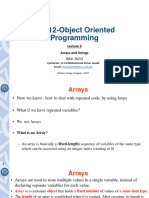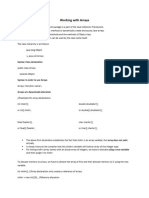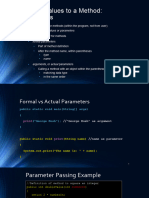0% found this document useful (0 votes)
31 views21 pages9 - Lec - Arrays in Java Part-2
The document discusses array syntax and initialization in Java. Arrays can be initialized using brackets or parentheses. An initializer list can be used to instantiate and fill an array. Multidimensional and ragged arrays are also supported.
Uploaded by
Aqeel AbbasCopyright
© © All Rights Reserved
We take content rights seriously. If you suspect this is your content, claim it here.
Available Formats
Download as PPTX, PDF, TXT or read online on Scribd
0% found this document useful (0 votes)
31 views21 pages9 - Lec - Arrays in Java Part-2
The document discusses array syntax and initialization in Java. Arrays can be initialized using brackets or parentheses. An initializer list can be used to instantiate and fill an array. Multidimensional and ragged arrays are also supported.
Uploaded by
Aqeel AbbasCopyright
© © All Rights Reserved
We take content rights seriously. If you suspect this is your content, claim it here.
Available Formats
Download as PPTX, PDF, TXT or read online on Scribd
/ 21
































































































